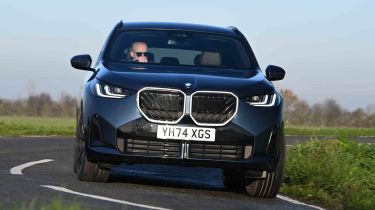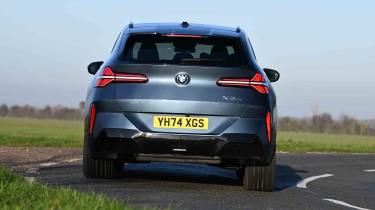BMW X3 - Engines, performance & drive
Fourth-generation X3 has sacrificed sharp dynamics for more comfort, but it’s still an engaging choice in the class

The previous BMW X3 was the first to be offered with plug-in hybrid tech, and the new 30e moves the game on thanks to a much beefier electrical portion of the powertrain.
In contrast to the old model, which at best could muster 107bhp from its electric motor, the 30e xDrive PHEV produces 181bhp. Combined with a 2.0-litre turbocharged petrol engine, there’s a very healthy 295bhp on offer. Usable battery capacity has grown from 12kWh to 19.7kWh, which gives the potential for 56 miles of electric-only driving.
There’s a 30d sold in Europe, but until the X3 M arrives, the most potent option in the UK is the M50 xDrive. The 3.0-litre petrol twin-turbo model gets mild-hybrid tech and produces 393bhp.
The engines which will make the most sense to most buyers, however, are the mild-hybrid petrol and diesel options. The 20 (now shorn of its ‘i’ suffix to avoid confusion with BMW’s electric models) and diesel-powered 20d make 204bhp and 194bhp, respectively.
| Model | Power | 0-62mph | Top speed |
| X3 20 xDrive | 204bhp | 7.8 seconds | 134mph |
| X3 20d xDrive | 194bhp | 7.7 seconds | 134mph |
| X3 30e xDrive | 295bhp | 6.2 seconds | 134mph |
| X3 M50 | 393bhp | 4.6 seconds | 155mph |
What is the BMW X3 like to drive?
Keen drivers coming from the old X3 are unlikely to be blown away by the new car’s responses, but it’s still one of the best options in the class to drive. The biggest improvement over its predecessor comes in its refinement, which is a step forward from the already high standards of the old car.
In town
When fitted with the 20 xDrive powertrain, the X3 moves off from rest near-silently, thanks to the 17bhp electric motor that supports the mild-hybrid system. With a modest battery capacity of just under 1kWh, the petrol engine soon needs to chip in, but the transition between the two parts of the powertrain is very smooth.
Used - available now
And that smoothness sums up much of the low-speed driving experience; the steering is light and responsive, so it’s easy to manoeuvre the car (although the turning circle is no better than average), while the ride manages to remain supple and does a great job of suppressing sharp bumps and potholes.
There’s optional adaptive suspension, too, on all cars except the M50, which gets it as standard. You’ll notice a slight edge to the ride in Sport mode around town, but there’s not a huge amount of difference switching to Comfort. You could happily leave it in Sport all the time.
On A- and B-roads
That compliance in the suspension doesn’t take anything away from the way the X3 handles a twisty road, either. While some mid-sized SUVs can feel a little wayward at speed, the BMW manages to provide fairly keen handling without unduly compromising ride comfort.
Body control is great, and once the tyres reach the limits of their grip, its balance remains neutral and predictable. It’s not a driver’s car in the traditional BMW sense – the steering is too light and short on feel for that – and that also means it doesn’t feel quite as involving to drive as its predecessor did. However, compared with its competition, it remains a more agile and composed option.
Most buyers won’t need to look beyond the entry-level engine option, with the four-cylinder petrol model giving strong performance when required, helped by a responsive eight-speed automatic transmission and that subtle electrical boost.
The BMW X3 M50 comes with uprated brakes (as you’d hope given the increase in engine output) with big, four-piston calipers over similarly impressive discs. While fitting huge brakes to a fairly sensible family car can often result in some grabby characteristics from the pedal, their power is complemented by confidence-inspiring pedal feel.
On the motorway
High-speed stability is impressive, and neither road noise nor wind noise is overly intrusive, which makes the X3 a solid long-distance cruiser. The engines remain hushed at speed, and the auto gearboxes shift smoothly under light throttle, so the experience all feels fairly effortless.
Engines, 0-60 acceleration and top speed
There are four engine options available in the BMW X3 in the UK. The 20 xDrive has 204bhp and 330Nm of torque from its 2.0-litre turbocharged petrol engine, for a 0-62mph time of 7.8 seconds, while the top speed is 134mph.
The 20d xDrive is the sole diesel engine offered in the UK, and it makes 194bhp and 400Nm of torque. This gives the X3 a 0-62mph time of 7.7 seconds and matches the 20 xDrive’s 134mph top speed.
As well as tax breaks, the plug-in hybrid 30 eDrive offers a combined output of 295bhp and 450Nm of torque. This is good enough for a 0-62mph time of 6.2 seconds, while the same 134mph top speed is on offer.
The M50 beats the rest of the X3 line-up by a healthy margin, in terms of power (393bhp and 580Nm of torque), acceleration (0-62mph in 4.6 seconds) and top speed (electronically limited to 155mph).















